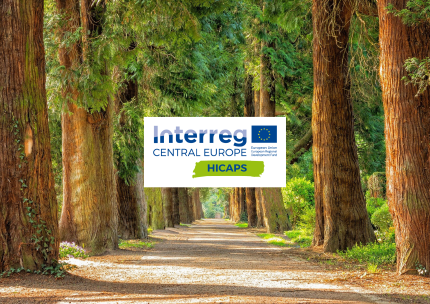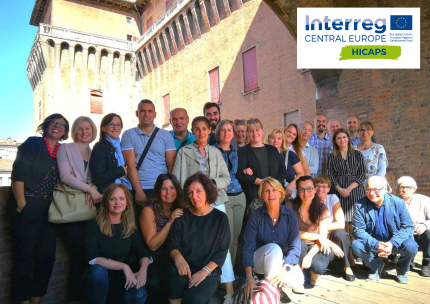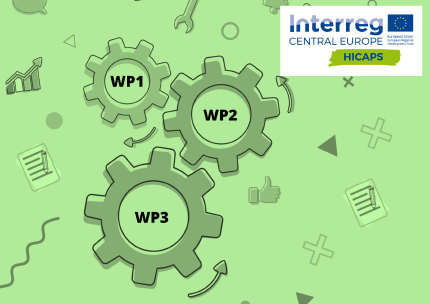HICAPS PROJECT SUMMARY

Parks and playgrounds are the soul of a city,” Marty Rubin once wrote, and we couldn’t agree more. In the past, parks not only served as a demonstration of city’s or states political or economic power, but as a gathering point for its citizens. These green oases provided peace, quiet, meditation, and escape from the busy streets of most urban areas throughout Europe. One could expect, as the rapid pace of urbanization in contemporary surroundings is taking bigger swings, the need for a bit of a greenery will grow exponentially. The need is there. The concrete attempts to build on that need are rare. In some parts, due to the lack of capacities (including common policies, know-how, resources), parks are rapidly deteriorating. Our task, as HICAPS project, was to help to stop that deterioration, and in that process, save the souls of our cities and preserve an important piece of Central Europe’s rich and diverse cultural heritage.
In order to do so, we’ve gathered 10 partners from Central European states of Croatia (Association “Petit Philosophy”; City of Varaždin; Municipality of Bedekovčina,), Italy (Municipality of Ferrara; Villa Ghigi Foundation, Bologna), Poland (Kujawsko-Pomorskie Voivodeship; Rzeszow Regional Development Agency joint-stock company), and Slovenia (Municipality of Velenje; Scientific research centre Bistra Ptuj; University of Ljubljana, Faculty of Architecture). We’ve all come together under the umbrella of an EU funding program Interreg CE, with the common goal – improving environmental management in urban areas and successfully using cultural heritage as a resource for local and regional development.

Our project HICAPS – HIstorical CAstle ParkS, which started in June of 2017 and ended in May of 2020, developed eight different concepts on how to revitalize eight different castle parks - by building different interactive contents and by developing tools we are enriching park spaces and turning them into places for spending time in, socializing, interacting, learning, and playing. Simply put, the idea was to renovate the space for renovation of the community! The task which we took upon us could be summarized using our motto – “Plan. Plant. Preserve!” This motto of the HICAPS project can be described through three thematic work packages we developed.

In the first work package, we have collected best transnational practices from the field. These best practices, together with technical, organizational and financial aspects of cultural areas management (with the proper analysis of national legislation and local regulations), are gathered into the transnational strategy on evaluation of cultural heritage and potentials of historical parks. By development of this strategy, which we offered to the local and regional authorities, we provided them with effective tools for planning and investment processes for parks. Together with that, as our objective is to revitalize eight different castle parks, we developed eight local action plans accordingly, in partner cities on cultural heritage and potentials of historical parks. By elaborating and adopting these concrete action plans, at the same time, we further develop and revitalize our historical heritage, fostering sustainable economic growth, and strengthening capacities of public and private sector for use of cultural heritage and resources. This is what we did inside first work package:
- Analysis Of National Legislation
- Good Practices Analysis Report
- Concept Of Transnational Strategy
- Report On The Most Appropriate Locations For Pilot Area
- Transnational Strategy On Evaluation Of Cultural Heritage And Potentials Of Historical Parks
In the second work package developed as a part of HICAPS project, we dealt with the tools necessary to tackle the common issues mentioned above, such as a lack of know-how, resources, and common policies. The tools we provided serve to support consensus building processes among public and private sector on the historical-social importance and educational with business opportunities which historical parks offer. By doing this, we provided support to public and private organizations for better balance between preservation of cultural heritage and sustainable socio-economic development. A total of twelve developed tools empower their users with valuable knowledge, and include documents such as Decision support tool with guidelines for the process of self-evaluation and use of cultural heritage; Educational outdoor trail tool, and Transnational e-handbook on the most appropriate tools to address people with disabilities in cultural landscape. Thus, we developed practical information and tools that can be an inspiration for everyone to bring some new, interesting and educational content to the parks. The second work package is there to bring all kinds of people to the parks, but also to bring parks closer to all the people!
This is what we produced through the second work package:
- Report On Workshops With Public Sector
- Quality Report On Preparation Of Materials
- Transnational Decision Support Tool
- Socio-Historical Report On Historical Parks
- Report On Plant Diversity And Their Value
- Quality Review Report On Accessibility Tools
- Report On Transnational Educational Outdoor Trail Tools
- Handbook On Landscape Accessibility For All
Last, third work package, is a practical culmination of the theoretical work previously done. The efforts on the last work package started with developing eight local revitalization concepts for specifically identified historical areas, and eight detailed technical plans and pilot actions reports. As we stressed at the beginning, on how overall task of the project is to revitalize eight different castle parks by May of 2020, the third work package is the final phase of the project, in which all of our previous endeavors came together. Implementing previously gathered and developed knowledge, with our tools and strategies from the first two packages, we revitalized eight different parks, all with different concepts. On the eight local pilot sites in Croatia, Italy, Poland, and Slovenia, focusing on reconstruction of small parts inside of identified parks’ area, and taking into consideration historical and new facts with solutions envisaged in our concepts, we improved parks’ benefits for the citizens and public administrations involved. We demonstrated their value as places for socialization, interaction, learning, and playing, accessible to all of its citizens and general public.
This is what we created through the third work package:
- Velenje Pilot Action Report - Municipality Of Velenje
- Bistra Ptuj Pilot Action Report - SRC Ptuj
- Bologna Pilot Action Report - Villa Ghigi Foundation
- KPV Pilot Action Report - Kujawsko-Pomorskie Voivodeship
- Varaždin Pilot Action Report - Municipality Of Varaždin
- MB Pilot Action Report - Municipality Of Bedekovčina
- Ferrara Pilot Action Report - Municipality Of Ferrara
- RRDA Pilot Action Report - Rzeszow Regional Development Agency
- Joint Pilot Evaluation Report (JPER)
HICAPS’ motto “Plan. Plant. Preserve!” through the perspective of the above described three working packages, represents something deeper. Plan doesn’t just include a theoretical approach to the issues, but an extensive process of research which resulted in eight local revitalization concepts for identified historical areas, eight local action plans, twelve tools, and one transnational strategy. When we highlight the idea that after plan comes plant, we don’t refer only to the trees that our parks are encircled with, but to all the infrastructural practical works that we did in our parks, and the ideas behind our work. The metaphorical seeds which we planted show that parks can be understood and used as green key points of every city, as places for learning, playing, and enjoying. Our seeds, we hope, will catch and spread their roots through eight pilot sites as we try to preserve(!) important pieces of European cultural heritage, raising the awareness of their value, and showing public and private sectors how to improve capacities for the sustainable use of cultural heritage and resources. We planned, we planted, and in the end, we hope, helped preserve the souls of our cities.
In case you want to contact our project's consortium and inquire further about HICAPS,
feel free to send a mail to our lead partners:
- Project Manager: Helena Knez (Municipality of Velenje, Slovenia) - helena.knez@velenje.si
- Communication Manager: Antonio Kovačević (Association Petit Philosophy, Zadar, Croatia) - antonio.kovacevic.unist
@gmail.com
